The pa-i-to Epigraphic Project
Alessandro Greco, Georgia Flouda
1. Purposes
‘The Linear B pa-i-to Epigraphic Project’ is an epigraphic and philological pilot project founded by Alessandro Greco and Georgia Flouda, designed to provide a new critical edition of a thematic selection of Mycenaean tablets from Knossos, housed at the Archaeological Museum of Heraklion and published in the reference text CoMIK (J. Chadwick – L. Godart – J.T. Killen – J.P. Olivier – A. Sacconi – I.A. Sakellarakis (eds.), Corpus of Mycenaean Inscriptions from Knossos, Vol. I: 1–1063 (1986); Vol. II: 1064–4495 (1990); Vol. III: 5000–7999 (1997); Vol. IV: 8000–9947; index to Vols. I–IV (1998), Rome – Cambridge).
The Project focuses on the tablets in which there is mention of pa-i-to /phaistos/, the ancient town of Phaistos. Considering that this is the second most frequent place name in the whole corpus of Linear B, these tablets form a large homogeneous group of ca 90 texts (including those attesting related ethnic adjectives), dating from LM II-LM IIIA to LM IIIA2-B1 (ca XV-XIII century BC).
The Linear B pa-i-to Epigraphic Project aims to integrate the epigraphic, palaeographic and philological data emerging from the study of these tablets with the archaeological context and the evidence collected during the excavations and field surveys conducted in the territory of Phaistos, in order to make an additional contribution to the knowledge of the history of the region during the Late Minoan III period. ‘The Linear B pa-i-to Epigraphic Project’ was born as a stand-alone branch of a wider area of research based on all the written and documentary sources concerning the site of Phaistos, from the Late Bronze Age to the Venetian period. This programme is currently under development as part of the ‘Phaistos Survey Project’, in close cooperation with the Ephoreia of Heraklion; this was originally founded and directed by Prof. Emanuele Greco (former Director of the Italian Archaeological School of Athens) and is currently directed by Prof. Fausto Longo (University of Salerno) and prof. Alessandro Greco (Sapienza University of Rome).
The originality of ‘The Linear B pa-i-to Epigraphic Project’ derives primarily from the introduction of a novel methodological approach to research, based on the use of advanced non-invasive, non-destructive and contactless digital photography technologies to create a new critical edition of the documents under examination. This methodology consists of the combination of two distinct procedures of digital acquisition – RTI (Reflectance Transformation Imaging) and 3D Laser Scanning.
These technologies have already been used with success in the field of Aegean studies. For example, the RTI technique has been applied to the Knossian tablets of the Evans Collection at the Ashmolean museum, while a wider research project based on the realisation of RTI and three-dimensional scanning of the Linear B tablets from Pylos housed at the National Archaeological Museum at Athens is currently being carried out by Dimitris Nakassis.
2.1 Phase One (at the Heraklion Museum): 3D, RTI
Two diverse procedures of digital acquisition were completed at the Museum of Heraklion during the missions.
- a) scanning of the tablets using a portable 3D Laser Scanner (see § 2.1.1);
- b) photography of the tablets adopting the Reflectance Transformation Imaging (RTI) technology (see § 2.1.2).
2.1.1 3D Laser Scanning
The 3D Laser scanner projects a laser light onto the object and picks up thousands of points per second together with their spatial coordinates. Since the laser light is produced at very low power it is not at all destructive, does not produce micro-overheating phenomena and is harmful neither to the operator nor to the object examined.
The 3D Laser scanner is able to capture even the smallest sign incised on the clay, and produces a three-dimensional model with a resolution of one hundredth of a millimetre. The data collected for each of the points is suitably ‘connected’ using specific algorithms for spatial geometry, thus enabling a series of mathematical analyses of the 3D model so generated, and these accentuate the signs. This approach follows the so-called curvature analysis, a technology which analyses the surface of the tablet and produces a false-colour map showing micro-changes in the gradient from the starting point of the sign engraved on the clay surface to its bottom. In this way the shape of an engraved sign is not ‘reconstructed’ or interpreted by the scholar or designer who reproduces it graphically, but is reproduced as a mathematical image.
This digital processing produces a three-dimensional model which can be easily handled in virtual space using freely available software. It can also be exported as a 3D PDF file, a cross-platform format which can be easily manipulated using the standard gestures for rotating, translating, zooming etc. on any touch device, or with a mouse on a standard screen.
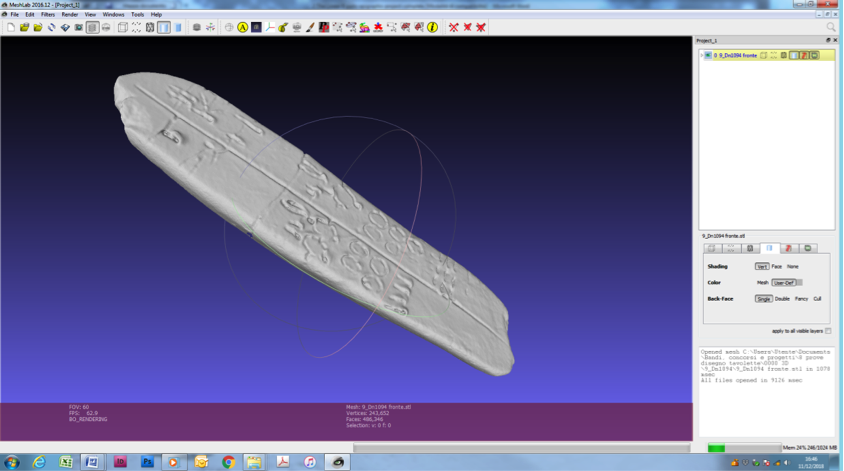
Example of a 3D image digitalized by the 3D scanner of the team.
During our missions, Emanuela Faresin and Giuseppe Salemi used a Geomagic Capture ultra-compact scanner, which uses blue-LED technology. This device captures almost one million points in just 0.3 seconds, so creating detailed models of the tablets with an accuracy of 0.034 ÷ 0.118 mm. See gallery
2.1.2 RTI (Reflectance Transformation Imaging)
RTI (Reflectance Transformation Imaging) is a computational photographic methodology which captures the shape and colour of an object’s surface, revealing a quantity of information which cannot be collected through a simple direct, empirical examination of a physical object. Unlike a common photograph RTI is interactive, allowing the user to modify the lighting on an object, producing an almost three-dimensional effect.
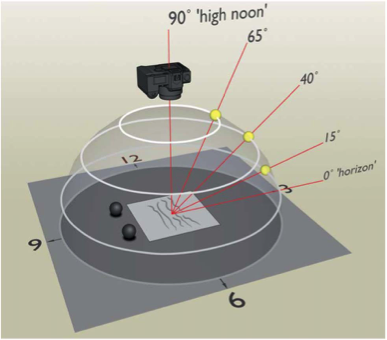
The lighting samples cover a range of inclination angles from 15 to 65 degrees above the horizon and an even sampling around the subject, all at a fixed distance from the subject.
RTI images are created from information derived from multiple digital photographs of an object, shot with a camera standing in a stationary position. In each photograph, the light is projected from different directions (generally the lightening source may be located in 12 different positions on a horizontal plane and, for each position, in 4-5 different angles). During this process a series of images (no less than 48) of the same object, with varying highlights and shadows, is generated.
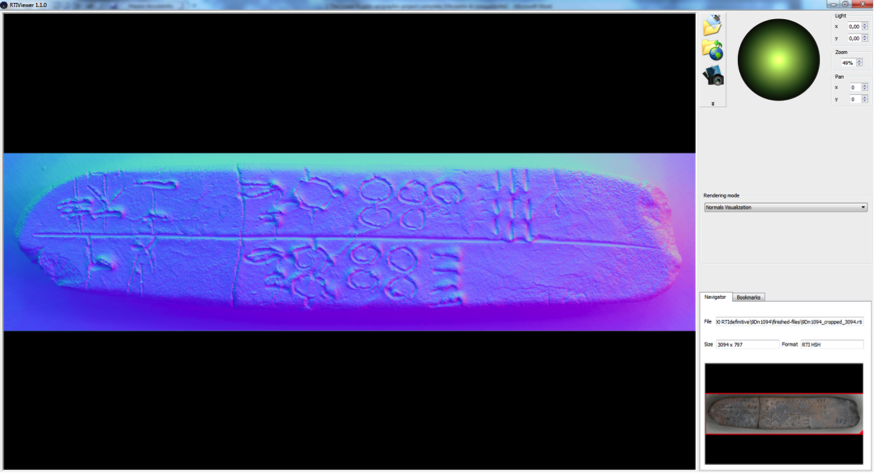
RTI image of KN Dn 1094
The lighting information is then synthesised into a unique mathematical model of the object surface and a single interactive image is so created (i.e. by using RTIbuilder™, a freely downloadable software). The advantage of this technique lies particularly in the possibility of reproducing the colour and tridimensional shape of the object with high levels of precision.
The RTI image so created can then be manipulated using one of a number of programmes (such as RTI viewer™) which allow the user to re-light it interactively from any direction by simply moving the mouse over the picture, and so virtually examine the surface of the object on a computer screen with a high level of precision; the shifting interplay of light and shadow on the RTI image brings out the finest details.
The RTI photos published on this website were realised by Alessandro Greco, with the help and support of Georgia Flouda, Emanuela Faresin and Erika Notti.
2.1.3 Archaeological Drawings
Traditional editions of the Linear B tablets contain facsimiles representing the inscribed surface of the supports, but these do not reproduce the three-dimensionality of the tablets, since the focus of these epigraphic drawings, however accurate, is on the inscriptions. The Linear B pa-i-to epigraphic project is designed to provide scholars with extra information which also takes into consideration the materiality of the tablets, and all the important implications deriving from this, such as the physical aspect of their formation and the manual touch of tablet-kneaders and scribes. The archaeological drawings of all the tablets examined, realised from a frontal, median and transversal aspect, were developed by Giuliano Merlatti.
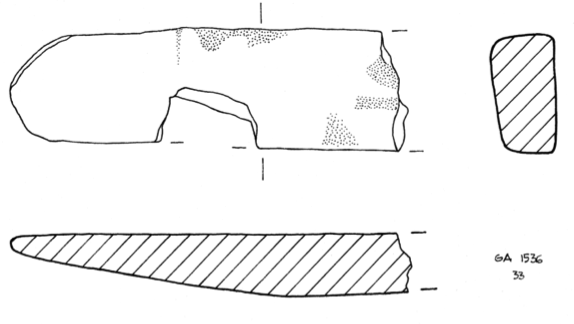
Drawing by Giuliano Merlatti
2.2 Phase Two – Processing of the Models: Epigraphic, Palaeographic and Philological Studies
The primary purpose of the second phase was to create 3D and RTI digital models, together with a complete epigraphic and palaeographic survey of the tablets, in order to prepare a new critical edition, for publication both in printed and digital form.
2.2.1 The Epigraphic and Palaeographic Study
Alessandro Greco and Sara Lopez have prepared a documentary epigraphic database using MS Access™ software. This database gathers and reorganises all the currently available information, and is based primarily on the reference text CoMIK. The data is classified as epigraphic (class, series, set, subset etc), archaeological (findspot, dating, record code, etc.), material (shape, size, colour, fractures etc), palaeographic (scribe, fingerprint, analysis of syllabograms, logograms etc.) or philological (interpretation, vocabulary, references etc.), so as to assemble a precisely codified documentary apparatus, with a specific focus on palaeography.
The technology adopted effectively shows up even the slightest variations on tablet surfaces, and so provides an effective new tool in the study of palaeography. With all due respect for the traditional printed publications – starting from the fundamental study by Olivier in 1967 (Les scribes de Knossos), and successive important works such as Palaima 1988 (The scribes of Pylos) and Driessen 2000 (Room of the Chariot Tablets) –, the pa-i-to project aims to exploit the advantages of these innovative technologies and create for the first time a freely accessible documentary apparatus, in which all the data and parameters used to obtain palaeographic results may be more easily verified and freely observed. In particular, the database is designed to include a specific palaeographic section concerning all the markers pertaining to the definition and the identification of every single syllabogram and logogram attested on the tablets.
All the relevant data in the above-mentioned reference texts and in successive specific studies on palaeography were taken into particular consideration during the phases of autopsy and imaging acquisition at the Museum.
The completion of the first phases of the project at the Heraklion Museum has led for the first time:
1) to produce a 3D scan of each tablet (with accuracy to a hundredth of a centimetre – 3D method);
2) to verify with mathematical accuracy the presence of any sign, intentional or unintentional, on the tablet surface (– 3D method);
3) to collect information concerning the exact size and shape of the tablets and the signs on them (– 3D & RTI methods);
4) to zoom in on and accurately observe the sign shapes with a far wider range of texture and colour detail (– RTI);
5) to view images of each tablet which can represent simultaneously 48-60 different points of lighting on the tablet surface, in a condition very similar to actual autopsy (– RTI).
On the basis of these starting points, Georgia Flouda, Alessandro Greco and Erika Notti, with the support of Sara Lopez, have been focusing on the epigraphic and palaeographic data emerging from this research.
The application of these innovative methodologies not only brings us to a fuller appreciation of the extraordinary accomplishments of leading scholars in the field, made even more evident by the conclusive and now freely available evidence concerning palaeographic data, but is also producing new research results.
One example is represented by the fresh observations arising from F(2) 841. During the earlier phase of philological and epigraphic study, based on the collection of the information derived from the currently available printed reference texts (CoMIK), Alessandro Greco and Georgia Flouda noticed that in the term currently read as mi-sa-ra-jo (F(2) 841.2) the horizontal stroke that normally characterises the shape of the last syllabogram, B36 jo, appeared to be missing, and this absence had also been suggested by old photographs. However, during the autoptic analysis of the tablet, they observed that the syllabogram B36 –jo– occurring also in lines.1.3.4 regularly shows both the horizontal and the vertical strokes.
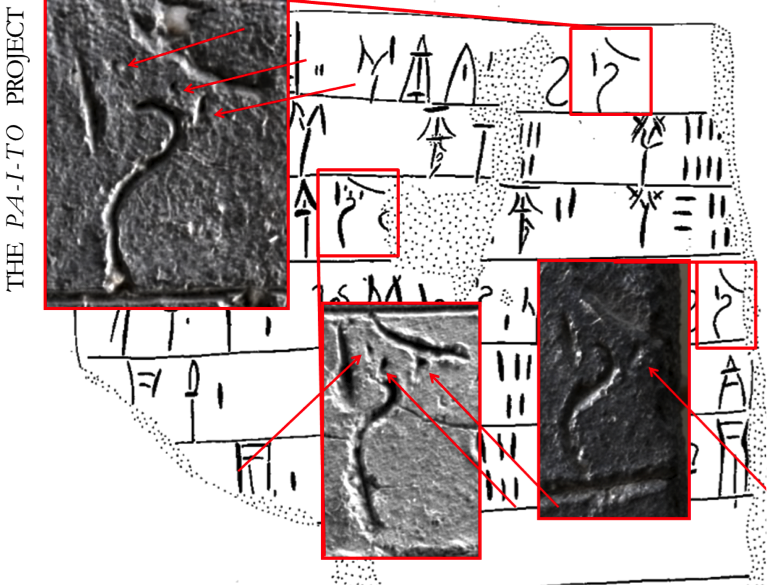
The strokes of syllabogram B36 jo (F(2) 841)
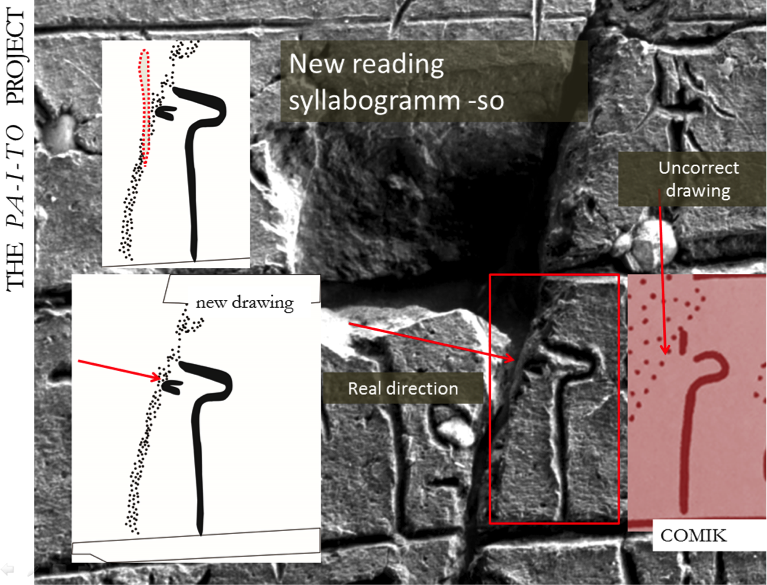
The strokes of the last syllabogram of the word mi-sa-ra-so (?) (F(2) 841)
It was at this point that the application of the RTI and 3D Laser Scanning technologies demonstrated that the initial observations could be definitively confirmed. A reading –jo– for the last syllabogram of the word in the fourth line is now to be ruled out, and that the sign is more likely to be identified with B12 so (Greco – Flouda, “The Linear B pa-i-to Epigraphic Project”, ASAA 95, 2018)
2.2.2 A New Set of Epigraphic Drawings
Following the phases of autopsy and RTI image acquisition, new digital drawings were created using the vector graphic tools provided by the software Adobe Illustrator™. Since these digital epigraphic drawings are based on RTI images they can be realised with an accuracy greater than one hundredth of a centimetre. Here lies another advantage of the application of RTI technology to epigraphic and palaeographic studies; to produce traditional facsimiles the strokes of syllabograms are usually drawn by hand on tracing paper laid over a 2:1 scale vertical photograph, and it goes without saying that in this case the degree of accuracy depends largely on the ability of the scholar.
Recently, several scholars (as announced for example by Del Freo and J. Zurbach in their preparation of a Supplement to GORILA) have preferred to use vector graphics, using layers superimposed on high-resolution photos, rather than the traditional hand-drawn sketches. Although this technique permits a greater degree of enlargement of the photographs, consequently increasing the accuracy of the drawings, these photos are still taken with a fixed light position and thus some limits remain, particularly evident when compared with RTI or 3D scans.
In fact, as shown in the picture below, it is clear that the visual perception of the strokes forming signs may vary with changes in light direction, and that this distortion increases when the image is enlarged. Therefore, one of the risks of the traditional techniques, whether the drawings be made by hand or digitally, is to reproduce not only the physical features of the intentional strokes, but sometimes also the shadows or deformations of their appearance caused by the lighting.
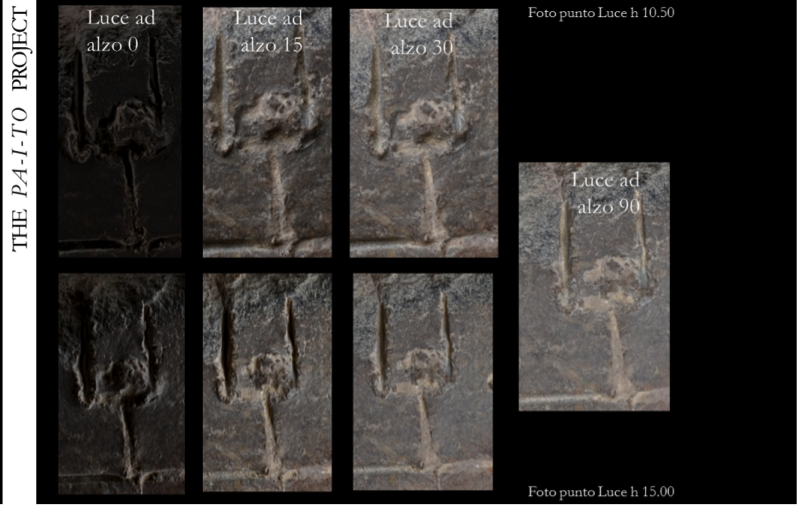
The same syllabogram AB 08 a seen with illumination from different directions.
In an effort to overcome this difficulty, we experimented with drawing by hand directly on the RTI image, taking advantage of the possibility to shift from one lighting angle to another with each stroke and so draw it as precisely as possible. However, we soon ran into another type of risk – an overabundance of information that may be indicated in the final drawing, for the sake of completeness and faithfulness to reality, but with the disadvantage of making the sign ductus difficult to make out. We have therefore come up with a compromise: to produce multi-layer vector drawings based on a set of superimposed photographs, including only high-definition photos with vertical lighting, photos with almost horizontal lighting and photos with lighting at 30 and 45 degrees, shot from different positions. In this way, the drawings offer a more balanced representation of the sure, salient features of each sign.
The pa-i-to Epigraphic Project Website has been created to render freely available online the results of the application of RTI and 3D Laser scanning techniques on a thematic selection of Mycenaean tablets, realised in the ambit of “The Linear B pa-i-to Epigraphic Project”. This website is intended to be gradually updated, and also includes essential comments on the photographic material presented, mainly for the purpose of dissemination.
The project is financed by:
– The “Dipartimento di studi Greco-latini italiani e scenico-musicali of Sapienza, University of Rome, under the aegis of the “Writing Techniques vs Technologies for Writing” project coordinated by Alessandro Greco, Georgia Flouda (Heraklion Archaeological Museum) and Lorenzo Verderame (Istituto Italieno di Studi Orientali) under the aegis of the “Nomi, soprannomi e pseudonimi. Forme e funzioni dall’antichità all’età moderna” project coordinated by . L. Bettarini (Università di Roma, La Sapienza), in collaboration with A. Greco, M. Di Marco and E. Tagliaferro (University of Rome, La Sapienza;
– The no-profit organization (ONLUS) “Gli amici di Minosse e Radamanto”.
The website is financed by:
The Department of Humanities of IULM University (Milan), under the aegis of the ‘The ‘From Tablet to Tablet’ Project. Exploring the Practical Applications of Imaging Techniques in Epigraphy and the Cultural Heritage” coordinated by Erika Notti, in close collaboration with the founders of The Linear B pa-i-to Epigraphic Project, Alessandro Greco and Georgia Flouda.
The ‘From Tablet to Tablet’ Project
Erika Notti, Giovanna Rocca, Mario Negri
The ‘From Tablet to Tablet’ Project. Exploring the Practical Applications of Imaging Techniques in Epigraphy and the Cultural Heritage (“Dalla Tavoletta al Tablet”. Indagini di imaging per applicazioni all’epigrafia e ai beni culturali), is a project funded by the Department of Humanities of IULM University (Milan, Italy) in order to advance epigraphic, palaeographic, philological and archaeological research, with particular regard to the field of Aegean studies. The ‘From Tablet to Tablet’ Project is coordinated by Erika Notti, with the participation of Giovanna Rocca and Mario Negri.
Its primary aim is to promote research in situ; publications both printed and digital (i.e. studies on texts selected by specific topic or from archives); the creation of databases and photographic and bibliographic repertoires; the development of interactive multimedia material for research and didactic purposes and the organisation of international events, workshops and conferences.
The project continues and develops a tradition, inaugurated by the Department of Humanities, of international joint ventures and symposia aimed at fostering Aegean studies, among which are worthy of mention those in close collaboration with the Sapienza University of Rome, such as “Colloquium Romanum” (XII International Colloquium on Mycenaean Studies, 20-25 February 2006, Sapienza University, Rome); International Conference on “Observations on Aegean Chronologies in the Light of the Recent Discoveries of Santorini” (27-28 April 2009, IULM University, Milan); Colloque International « Un millénaire d’histoire et d’archéologie chypriotes (1600-600 av. J.-C.) » (18-19 October 2012, IULM University, Milan); Colloque International « Le sacrifice humain dans le monde égéen et dans les civilisations périphériques », (27-28 October 2014, IULM University, Milan); Colloque International « Les Échanges dans les civilisations de L’Orient, de l’Égypte et de la Méditerranée à l’âge du Bronze » (4-5 May 2017, IULM University, Milan).
Among the various lines of research currently ongoing under the aegis of the ‘From Tablet to Tablet’ Project the one which inspired its name is based precisely on the adoption of an innovative methodological approach to the study and publication of archaeological finds, ancient texts and inscribed supports, based on the application of advanced non-invasive digital imaging technologies. A fruitful renewed cooperation between the so-called ‘hard and soft sciences’ has recently opened fresh horizons, and the quest for the most advantageous equilibrium between the two represents the true challenge, both now and in the future.
In epigraphy, the recent application of technologies such as Reflectance Transformation Imaging (RTI) or 3D Laser Scanning has shown that new scientific results may be attained, not only providing further objective data with which to evaluate, provide further support to or refresh the currently available picture, but also making it possible to realise high-resolution reproductions of the finds, thus permitting their virtual (re-)examination – although a direct autopsy of the finds naturally remains an ineliminable first step in any research.
Such versatile technologies have a wide range of advantages and applications. They are not only useful tools in research, but also in the field of Cultural Heritage and in active and interactive learning, in terms of documentation, preservation, dissemination, and aesthetic appeal. The mission of the ‘From Tablet to Tablet’ Project is to preserve and disseminate knowledge, encourage learning and further research, and this is the primary objective of the present website.
This website has been designed with the precise intent of providing a freely available, interactive tool not only for specialist scholars, but also for a wider public and to all those with an interest in the history of mankind and in one of his greatest inventions – writing.
Its primary function is to present a selection of Mycenaean tablets, reproduced in the form of interactive RTI images and 3D laser-scanned models, which from a point of view both quantitative and qualitative make up a coherent and suitably thematic group of texts. Besides the interactive photos, we have also decided to include some essential information concerning the physical characteristics of the supports, the contents, and the epigraphic and palaeographic data, provided mainly for the purpose of dissemination.
We have focused on those Mycenaean tablets attesting pa-i-to, a recurring place name, generally interpreted as /Phaistos/ (: Φαιστόϛ), whose geographical localization in the plain of the Mesara, to the south of the river Ieropotamos, is unanimously agreed upon. Pa-i-to (and the related ethnic adjectives) is widely attested in the documentation, thus the website will contain no less than 90 Mycenaean tablets and fragments. This website will gradually be updated as research goes on, and fresh scientific results will subsequently be presented in a more extended form in printed publications.
This website is maintained thanks to the support of the ‘From Tablet to Tablet’ Project, coordinated by Erika Notti, in close collaboration with Alessandro Greco (Sapienza, University of Rome) and Georgia Flouda (Heraklion Archaeological Museum).
The ‘Rhadamanthys’ Digital Archives’ Project. New Technologies for Research and Enhancement of Archaeological and Epigraphic Evidence from the Ancient Mediterranean
(ed. Erika Notti)
‘Rhadamanthys’ Digital Archives’. New Technologies for Research and Enhancement of Archaeological and Epigraphic Evidence from the Ancient Mediterranean (“Archivi digitali di Radamanto”. Nuove tecnologie per la ricerca e la valorizzazione di documenti archeologici ed epigrafici dal Mediterraneo antico”), is a research project funded by the Department of Humanities of IULM University (Milan, Italy) in order to promote research, dissemination and the enhancement of the Mediterranean cultural heritage. Among the primary aims of the Project are: the development of on-site studies in archaeological sites and museums and activities for research and didactic purposes; the organization of public lectures, workshop, conferences and international events.
The research deals with the history and archaeology of the Aegean region within the Eastern basin of the Mediterranean, focusing on the cultures, languages and (verbal and non-verbal) communication systems of pre-classic civilizations. Particular attention is attributed to early attempts at bureaucracy, administration and writing practices connected with the development of palatial societies. The lines of research are articulated on multidisciplinary levels of analysis – historical, archaeological, linguistic, philological, epigraphic, paleographic and pinacological. The research focusses primarily on a selection of Minoan documents in order to investigate the spread of writing in the Bronze Age Aegean – i.e. cretulae, administrative and non-administrative texts, sealed documents, tablets, marks – and the relationships between Cretan scripts. In particular, this line of research leads towards the archives of Phaistos in Cretan Mesara, which has so far yielded several unique examples alluding to the “dawn of writing” and early experimental attempts at using Cretan scripts.
‘Rhadamanthys’ Digital Archives’ thus draws inspiration from the heuristic heritage of Italian pioneers in Aegean studies. The first results of the Project have therefore been presented during the Enrica Fiandra’s Memorial Day (20th April 2024, Montafia-Bagnasco AT) – the public event organized by IULM (Erika Notti, Giovanna Rocca, Massimo De Giuseppe, Filippo Avilia), in close collaboration with CIRAAS (Centro Centro Internazionale Ricerche Archeologiche, Antropologiche e Storiche) and the Municipality of Montafia.
The first reports (“Rendiconti”) of the speeches given by the Italian and international scholars who gathered on that occasion are included in “QUADERNI LOMBARDO-PIEMONTESI. Epigrafia, glottologia e letteratura”, a new series of scientific fascicules relating to epigraphy, historical linguistics and literature, directed by Erika Notti, with the collaboration of Mario Negri, Renato Gendre and Mario Enrietti, printed by Tipografia Astese (I 2024 – forthcoming).
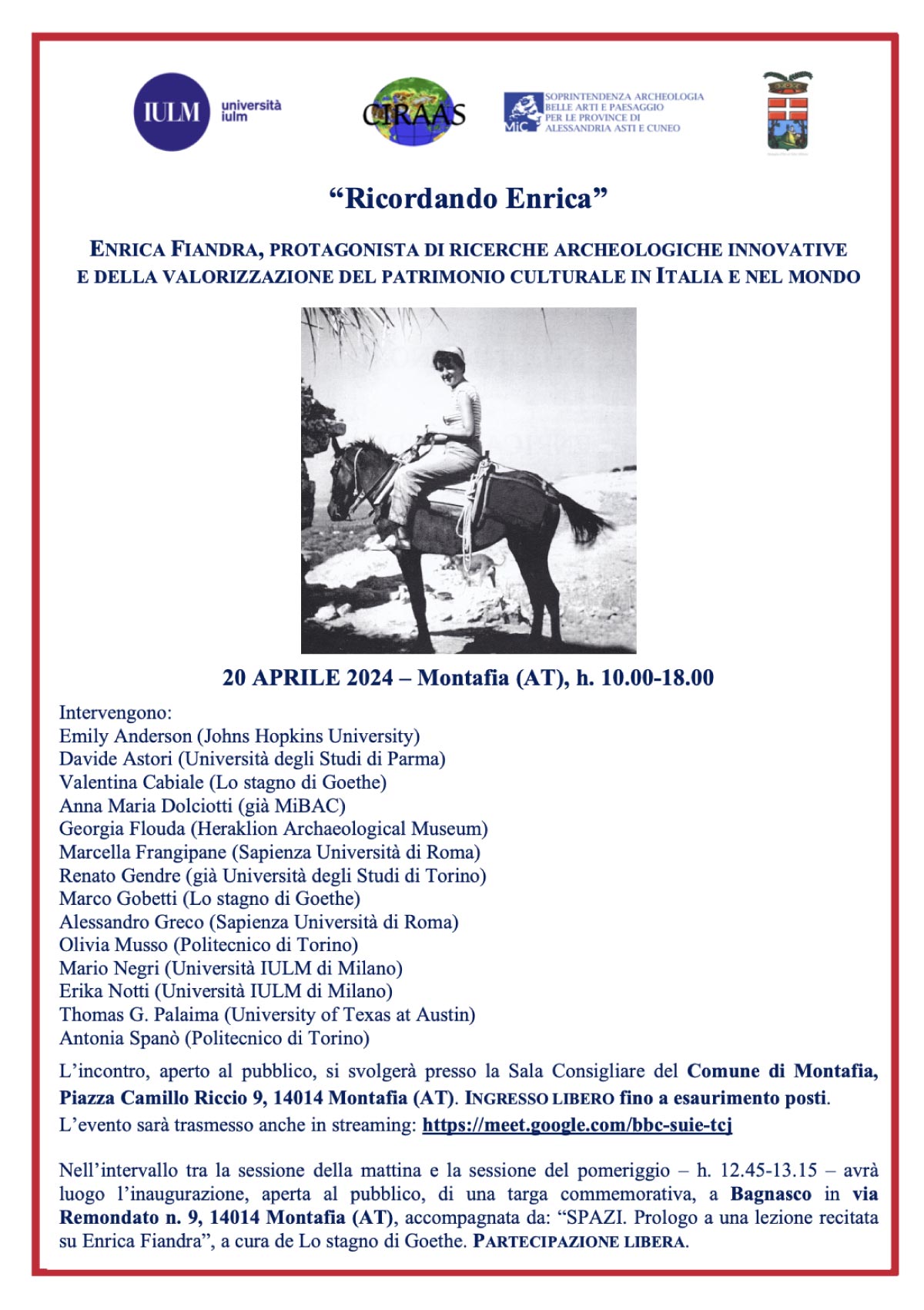
In recent years, digitalisation and new archaeometric and advanced imaging techniques have proved to be formidable supplementary research tools, acting as a powerful catalytic spurring renewed fervour in the fields of archaeology, epigraphy, palaeography and cultural heritage in general. The ‘Rhadamanthys’ Digital Archives’ Project therefore shares the mission of the Pa-i-to Epigraphic Web Project continuing the collaboration between Alessandro Greco, Georgia Flouda and Erika Notti started in 2017. Therefore, the Pa-i-to website now includes informative and photographic materials resulting also from the collaboration of Rhadamanthys’ Project, in its related sections organized by specific topic (Missions and Linear A).
This website is constantly and gradually updated as researches go on, and new scientific results are presented in a more extended form in printed publications.
The authors wish you pleasant navigation.
***
Data License. The 2D+ and 3D-models of artifacts presented in the database of paitoproject are for scientific, non-profit use of scientists. All 2D+ and 3D-models are subject to copyright laws with all rights reserved.
Reproduction, publication or commercial use of these 2D+3D-datasets is strictly prohibited without prior written permission. For further information, contact: Prof Alessandro Greco a.greco@uniroma1.it




